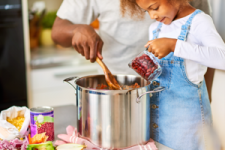Involving kids in planning and preparing meals teaches them food skills and the importance of healthy eating.
On this page
Benefits of involving kids in planning and preparing meals
You can teach your kids important food skills to set them up for a lifetime of healthy eating.
By involving kids in planning and preparing meals, you can:
- nurture healthy eating habits
- increase their self-confidence
- share culture and family traditions
- give them hands-on learning experiences
- stay connected and spend quality time together
- encourage picky eaters to try foods they helped prepare
- set the foundation for children to learn and improve food skills
Kids can learn:
- how to:
- grocery shop
- harvest foods
- build a healthy meal
- decrease food waste
- healthy food habits and skills
- the importance of healthy food choices
- how food relates to culture and food traditions
Involving kids in planning and preparing meals teaches them other important life skills like:
- budgeting
- organizing
- reading a recipe
- writing a grocery list
- following instructions
- measuring ingredients
These real life examples support other skills they are learning like:
- math
- writing
- reading
- sciences
- social studies
It’s never too late to start teaching your kids food skills.
How to involve kids in planning and preparing meals
All family members, including kids, can help with age-appropriate food activities.
Planning
Involve the whole family in planning meals and snacks.
Family members can help in different ways by:
- choosing meals or recipes
- adding foods to a grocery list
- checking the fridge and cupboards
- checking flyers for healthy foods on sale
- putting together a folder of favourite recipes
Choosing
Turn grocery shopping into a learning event. Here are a few ideas to try:
- let your kids pick out a new vegetable or fruit
- ask your kids to find ingredients and pick out produce
- ask your kids to choose a new whole grain food to make together
- have older children read the food labels and help choose healthier foods
- have young children count the number of vegetables and fruits being added to the shopping cart
Preparing
Everyone can help prepare meals.
Make it easy by:
- posting your meal plan in the kitchen
- giving each person a task such as:
- setting the table
- measuring ingredients
- preparing and making the food
Age-appropriate meal planning and preparing tasks
When you teach your children basic food skills, don’t forget to go over kitchen safety rules. Show them how to use kitchen tools such as a grater, peeler or whisk safely.
Use these age-specific ideas to help your little chef succeed in the kitchen.
Children aged 2 to 3 years can:
- count ingredients
- add ingredients to a bowl
- wash vegetables and fruit
Children aged 3 to 4 years can:
- help gather ingredients
- mix ingredients in a bowl
- pour from measuring cups
- help make a sandwich or pizza
- mash sweet potatoes or bananas
Children aged 4 to 6 years can:
- set the table
- stir ingredients together
- use a children’s knife to slice:
- tofu
- soft fruits
- cooked vegetables
Children aged 6 to 8 years can:
- crack and beat an egg
- toss foods together in a bowl
- make their own easy breakfast
- use basic kitchen equipment such as a blender or can opener
Children aged 8 to 11 years can:
- use a knife to cut:
- tofu
- bread
- cooked meat
- easy-to-grip vegetables and fruit
- make and pack their school lunch
- use the microwave and stove, with your help
- prepare a fresh veggie or fruit platter to go with dinner
Pre-teens and teens can:
- follow more complex recipes
- assemble and mix most ingredients
- be in charge of making meals on specific days
Cooking with your kids can also be a great time to talk to them about foods safety. Review important steps they can take such as washing their hands or cooling cooked food appropriately.
Try a family food adventure
Food is a fun way to connect as a family. Find an activity that works for your schedule.
You can take a family field trip to:
- go fishing to catch your own food
- shop at a farmer’s market to explore the variety of fresh foods
- visit an apple orchard to see how many different types of apples grow
You don’t need to go far to have a family food adventure. Try:
- making a new recipe together
- watching your favourite cooking show
- growing your own herbs and vegetables
- taking a cooking class together in your community
Make a healthy choice
What you eat on a regular basis matters for your health.
- Choose foods that have little to no added sodium, sugars or saturated fat.
- Compare the nutrition facts table on foods to choose products that are lower in sodium, sugars or saturated fat.
- Date modified:


